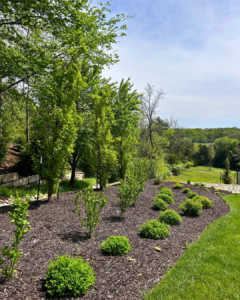As fall progresses in northeast Kansas, cooler soil temperatures create ideal conditions for planting bulbs that yield spring-blooming perennials. Getting these bulbs safely into the ground by the end of November (weather dependent, of course) will result in bursts of vibrant color when spring rolls around – a welcomed sight for sore eyes. Are you looking for ways to improve your curb appeal and add visual interest to your landscape? Check out 4 of our team’s favorite spring-blooming perennials that can do just that!
Hyacinth
Add rich hues to your landscape with these fragrant spring bloomers. Hyacinths do best when planted in areas where they will receive full sun. Their tall, spikey stalks also provide great visual contrast with other spring bloomers on our list of favorites! Pro Tip: Group hyacinths into large groups to maximize their fragrance!
Tulip
These cup-shaped beauties are available in nearly every color and herald the onset of spring. Tulips thrive in well-drained soil and should be planted in areas with full-sun exposure. Pro Tip: Interplant tulips with daffodils to help ward off hungry squirrels and deer that love snacking on them.
Daffodil
Celebrated as one of the longest-living bulbous perennials, daffodils are said to easily out-live the people who plant them! Daffodils prefer neutral soil with good drainage and bloom best when grown in full sun. Pro Tip: Interplant these with grassy plants so that when the perennial’s foliage turns yellow, you can minimize the visual impact on your landscape.
Crocus
Low-growing, adaptable, and vibrant, crocuses in bloom are one of the first natural indicators that spring is right around the corner! As with other bulbous perennials, the crocus prefers well-drained soil and full-sun exposure. Pro Tip: Incorporate and layer crocus with other spring-flowering bulbs that will bloom at different times and that have different heights to create longer-lasting seasonal interest.
Important info on caring for bulbs after they’ve bloomed
One of the most important things to understand about bulbous perennials is how they store their nutrients. After these forms of perennials bloom, their foliage will soon turn yellow and wilt. While you may be tempted to cut these back after their done blooming, please don’t! The plants need time to move their nutrients back down in the bulb, and cutting them back too quickly will decrease the amount of nutrients the bulb can store for future use. This will impact the flower quality of the bulbs in the future.
Make your landscape colorful throughout the seasons!
Our team of horticulturalists and plant enthusiasts love to talk about plants and their care. Do you have ideas or goals for your landscape? Let our team work with you to make those dreams a reality. From landscape design and installation to routine maintenance and irrigation, our team is here to help bring your outdoor imagination to life! Let’s start planning today!




